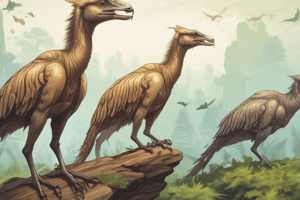Podcast
Questions and Answers
What is a species?
What is a species?
- A group of organisms that eat the same food
- A group of organisms with identical genetic material
- A group of organisms that live in the same geographical area
- A group of organisms that can produce fertile individuals through natural reproduction (correct)
What is responsible for the formation of new species?
What is responsible for the formation of new species?
- Genetic variation (correct)
- Climate change
- Population size
- Food availability
What led to speciation besides genetic variation?
What led to speciation besides genetic variation?
- Geographical and reproductive isolation (correct)
- Changes in environmental temperature
- Migration patterns
- Changes in diet
When did the last dinosaurs disappear?
When did the last dinosaurs disappear?
Which animal group did monkey-like animals evolve from around 7 crore years ago?
Which animal group did monkey-like animals evolve from around 7 crore years ago?
Where did ape-like animals evolve into gibbon and orang-utan?
Where did ape-like animals evolve into gibbon and orang-utan?
When did the gorilla and chimpanzee evolve?
When did the gorilla and chimpanzee evolve?
What caused ape-like animals to stand in an erect posture?
What caused ape-like animals to stand in an erect posture?
What is the approximate time period when the first human-like animals with erect posture evolved?
What is the approximate time period when the first human-like animals with erect posture evolved?
Where were the first records of a human-like animal, 'Ramapithecus', found?
Where were the first records of a human-like animal, 'Ramapithecus', found?
Study Notes
Speciation
- Speciation is the formation of new species of plants and animals due to evolution
- A species is a group of organisms that can produce fertile individuals through natural reproduction
- Each species grows in specific geographical conditions, with unique food habits, habitat, reproductive ability, and period
- Genetic variation, geographical changes, and reproductive isolation can lead to the formation of new species
- These changes can result in the formation of new species from an existing one
Human Evolution
- The biodiversity we see today originated from simple unicellular organisms due to evolution
- The origin of human evolution can be traced back to the time when dinosaurs disappeared (approximately 70 million years ago)
- Monkey-like animals evolved from ancestors similar to modern lemurs in Africa
- These animals lost their tails around 40 million years ago and developed enlarged brains and improved hands, eventually evolving into ape-like animals
- Ape-like animals migrated to South and North-East Asia, evolving into gibbons and orangutans
- Remaining ape-like animals in Africa evolved into gorillas and chimpanzees around 25 million years ago
- Some ape species used their hands more for eating and other tasks, leading to further evolution
Journey of Human
- These ape-like animals started living on land as forests declined due to dry environments
- Their pelvic girdle developed, allowing them to stand upright in grasslands, making their hands available for use
- The first human-like animals with erect posture and using their hands evolved around 20 million years ago
- The first record of a human-like animal is Ramapithecus, found in North India and East Africa
- Over time, these apes grew in size, became more intelligent, and evolved into different species
- The evolution of Homo sapiens is marked by key milestones, including the emergence of ancient humans, Neanderthals, and Cro-Magnon man
Studying That Suits You
Use AI to generate personalized quizzes and flashcards to suit your learning preferences.
Description
Discover the process of speciation, the formation of new species through genetic variation, geographical changes, and reproductive isolation. Learn about the characteristics that define a species and how they evolve over time.




